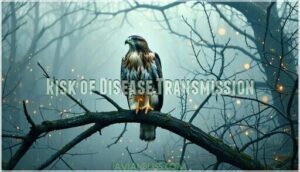This site is supported by our readers. We may earn a commission, at no cost to you, if you purchase through links.
 You’re probably wondering, are hawks dangerous to humans? Most of the time, you’re safe—hawks steer clear of people. But if you wander near their nests during breeding season, you might get more attention than you bargained for.
You’re probably wondering, are hawks dangerous to humans? Most of the time, you’re safe—hawks steer clear of people. But if you wander near their nests during breeding season, you might get more attention than you bargained for.
Hawks have sharp talons and strong beaks, so a surprise close encounter could sting, especially if you’re not protecting your head and eyes. These birds rarely attack without a reason, usually feeling threatened or trying to keep their chicks safe.
Stay alert, respect their space, and you’ll both avoid trouble. Curious about hawk signals or how to keep your yard hawk-free? Read on.
Table Of Contents
Key Takeaways
- You’re generally safe around hawks—they attack humans less than 0.1% of the time they encounter them, preferring to avoid confrontation entirely.
- You’ll face the highest risk during breeding season when you accidentally wander near their nests, as protective parents will dive-bomb or strike with sharp talons to defend their young.
- You can prevent most encounters by staying at least 100 yards from nesting areas, removing food sources that attract prey to your yard, and supervising small pets outdoors.
- If you do face an aggressive hawk, don’t run—instead, stay calm, protect your head and eyes, make loud noises, wave your arms to appear larger, and use an umbrella or similar object as a shield.
Why Hawks Attack Humans
Hawks don’t usually have it out for humans specifically – their attacks are more about survival instincts kicking in.
Hawks tend to attack if they feel threatened, especially when you come too close to their nests or territory.
Factors That Trigger Hawk Attacks
Hawks get aggressive for pretty straightforward reasons. They’re usually protecting their territory when food is scarce or bad weather has them on edge.
Quick movements, sudden sounds, or anything that catches the light wrong can set them off – they read these as potential threats and react accordingly.
Environmental Factors like storms can ramp up aggressive behavior, making defensive hawk behavior more common as they react quickly to any perceived intrusion.
Territorial Behavior and Nest Protection
When you’re near a hawk’s nesting area, especially during nesting season, expect some serious Nesting Site Defense. Hawks show aggressive behavior to protect their young and territory.
Territorial marking isn’t just for show—it’s about safety. Respect these boundaries for your own safety and for bird conservation. Give hawks plenty of space to avoid any territoriality drama.
Provocation and Human Encroachment
When you enter a hawk’s space, Hawk Encounters can turn risky fast. Human Threats, like walking too close to nesting areas, trigger territorial disputes. Urban growth creates more human interaction and potential nesting conflicts.
Steer clear of sudden moves; hawks see these as aggressive behavior. Respect wildlife boundaries to prevent unnecessary hawk attacks and avoid escalating territorial behavior.
Self-Defense Mechanisms
Hawks pack serious weapons—razor-sharp talons and beaks that can do real damage. If you’re dealing with an aggressive hawk, here’s what works:
- Don’t corner them—give hawks space to escape instead of backing them into defensive mode.
- Shield yourself with whatever’s handy—an umbrella, jacket, or thick blanket works great against those talons.
- Prevention beats confrontation—scarecrows, reflective tape, or even fake owls can keep hawks away from your property.
Risks and Dangers of Hawk Attacks
You may not expect a hawk to pose a real risk, but their sharp talons and beaks can cause injuries if you get too close.
It’s important to understand the specific dangers these birds present, including the possibility of wounds or disease transmission, so you can stay safe outdoors.
Common Injuries and Wounds
If a hawk decides you’re too close, you may experience Talon Injuries or Beak Wounds, especially around your head or hands. Claw Attacks can leave Puncture Marks and Head Trauma isn’t uncommon.
While hawk behavior toward humans is usually cautious, the Dangers of hawk attacks mean you should promptly treat all Injuries and Wounds before they get worse.
Risk of Disease Transmission
Hawks can carry diseases, though transmission to humans isn’t common. Whether you encounter one in the wilderness or near your home, these birds can harbor pathogens like Salmonella, West Nile virus, and avian influenza.
Infections happen mostly through contact with droppings, wounds, or contaminated surfaces. As a rule, avoid direct contact to block the spread of diseases by hawks. Understanding bird flu risks is vital for safety around infected birds.
Emotional Trauma and Stress
Beyond physical injuries, hawk attacks can leave lasting emotional scars. Many people develop genuine trauma responses after being targeted by these powerful birds.
The psychological fallout often surprises victims—what starts as a shocking encounter can spiral into persistent anxiety, especially when the attack comes without warning. Once you’ve experienced a hawk’s aggression firsthand, their behavior feels completely unpredictable.
Common reactions include:
- Fear outdoors
- Anxiety near birds
- Jumpiness at sudden noises
- Nightmares
- Avoiding certain spaces
- Heightened alertness
- Difficulty relaxing
- Difficulty trusting animal behavior
These risks of hawk attacks deserve attention and self-care.
Rare but Deadly Attacks
If you ever cross paths with a hawk on edge, you might wonder if those deadly talons pose a real risk. Fatal hawk encounters are so rare they’re almost myths—hawk behavior toward humans simply isn’t that aggressive.
Still, stay alert, use attack prevention strategies, and know that risks of hawk attacks remain extremely low. The capture of aggressive birds like the one in the hawk attack story highlights the importance of being aware of one’s surroundings when interacting with wildlife.
Vulnerable Groups: Children and Pets
Kids and pets face unique risks from hawk attacks, so your guard matters. Even everyday strolls can pose threats—hawks are territorial.
Protect your loved ones with these key actions:
- Use short leashes outdoors.
- Teach calm responses for Child Hawk Attacks.
- Supervise kids and pets in open spaces.
Mastering these Pet Safety Tips bolsters Vulnerable Group Protection.
Understanding Hawk Behavior
Hawks are fiercely territorial creatures that patrol their domain with sharp eyes. The moment something crosses into their space, they react swiftly and decisively.
Once you understand what motivates these behaviors, their seemingly aggressive responses to humans start making perfect sense.
Hunting and Foraging Habits
Hawks might be fierce predators with razor-sharp vision, but don’t worry—they’re not coming after you.
These birds have their hunting down to a science: they’ll circle high above, scanning for movement, then dive with deadly accuracy when they spot their target.
Their foraging strategies and prey selection change with the seasons as part of the larger food chains.
| Hunting Techniques | Foraging Strategies |
|---|---|
| Soaring | Seasonal adaptation |
| Swooping | Prey selection |
Nesting and Breeding Patterns
Once you understand how hawks hunt, their nesting behavior makes perfect sense. When breeding season arrives, these birds seek out the tallest, most secure spots they can find—towering trees, rocky cliff faces, anywhere that gives them a commanding view and keeps predators at bay.
The partnership between hawk parents is remarkable: they alternate between sitting on eggs and later teaching their young the survival skills they’ll need.
Helpful facts on hawk breeding and nesting sites:
- Hawks pick high, hidden nesting sites.
- Breeding season is spring.
- Both parents guard eggs.
- Fledglings learn to hunt nearby.
- Nesting habits change with habitat.
Territorial Marking and Defense
Picture a hawk’s “border patrol” in action. Hawks mark their territorial boundaries using sharp calls and sky-high duels, setting clear rules for rivals.
Their defense mechanisms kick in if intruders cross the line—expect aggressive flying and loud warnings.
These hawk behavior patterns help protect nesting strategies, showing just how important territorial behavior and hawk communication are to their way of life.
Social Behavior and Interactions
When you’re around hawks, knowing their social side makes a difference for staying safe. These birds aren’t always solo acts—they’ll group up and put on quite a show in the air.
Here’s what their social behavior, flock patterns, and communication mean for you:
- Flock Dynamics and Social Hierarchy during migration
- Aerial displays and mate selection rituals
- Hawk communication through calls and body language
- Cooperative hunting in certain species
Observing these behaviors helps reduce aggressive or territorial encounters during human-hawk interactions.
Signs of Agitation and Stress
Awareness keeps you a step ahead when reading Hawk Body Language. If you spot Agitation Signs like wing flapping, head bobbing, or tail fanning, know you’re dealing with Stress Behaviors.
Watch for Warning Cues: high-pitched screams, direct eye contact, raised feathers, and stiff posture are all Threat Displays. These Signs of hawk agitation may come before aggressive or defensive behavior—a clear signal to step back, giving the bird distance while protecting your safety from a hawk attack.
Preventing Hawk Encounters
You can reduce the chance of a hawk encounter by staying alert in areas where these birds are common, especially near nesting sites.
Taking simple precautions, like keeping pets close and removing food attractants, lowers the risk of unwanted interactions.
Avoiding Hawk Habitats and Territories
If you want to avoid trouble with hawks, stay alert near Wildlife Corridors and steer clear of areas with active Nesting Sites, especially during Hawk Migration.
Give their Territorial Boundaries plenty of respect—at least 100 yards.
Observing hawk behavior patterns means understanding their habitats and ecology, so you and the birds aren’t competing for the same space.
Removing Attractants and Prey Sources
Keeping hawks out of your yard starts with removing attractants and prey sources, which keeps both you and your pets safer. Hawks follow the food, so a little Yard Cleanup goes a long way. Get started with these three steps:
- Yard Cleanup: Clear away brush, fallen fruit, and unsecured trash cans to make your yard less appealing to rodents and small animals—prime hawk prey.
- Bird Feeder Management: Use hawk-proof feeders or take feeders down if you notice frequent hawk visits.
- Pet Food Security: Always pick up pet food right after feeding to remove food sources and prevent unwanted hawk encounters.
Smart Food Source Removal equals better hawk attack prevention.
Using Deterrents and Repellents
Once you’ve handled the obvious stuff like food and shelter sources, it’s worth stepping up with some hawk repellents and bird deterrents.
Try visual scarecrows, shiny tape, or a decoy hawk to break up a predator’s line of sight. Noise devices, like banging pots or motion-activated sprinklers, can make any hawk second-guess lingering in your space.
Protective Gear and Clothing
When protecting yourself from hawks, gear up smart. Hawk Proof Hats or helmets help block talons during surprise swoops. Safety Glasses or face masks keep your eyes safe from sharp beaks.
For added comfort, wear Protective Vests or tough, layered arm guards to soften any blows.
Choosing recommended safety gear is a strong step in self-defense and helps you keep hawk attacks at bay.
Educating Children and Pets
After putting on the right gear, it’s smart to turn your attention to educating kids and pets. Use real talk about Hawk Awareness and what to do—or not do—when spotting one. Explain why respecting their space matters, and ensure your pets stay near you. These practical Pet Safety Tips and Child Education steps help reduce Wildlife Encounters and aid in protecting yourself from hawks during their nesting habits.
Teaching Children Protecting Pets
Responding to Hawk Attacks
If a hawk approaches aggressively, you should know how to respond to reduce your risk of injury.
In this section, you’ll learn clear steps to protect yourself and stay safe when facing an unexpected encounter.
Staying Calm and Assertive
In the heat of a hawk encounter, keep a calm demeanor and assertive posture. Stand tall—think “tree,” not “mouse.” Use these Hawk Encounter Tips:
- Maintain a safe distance. – Stand your ground without running. – Make steady, loud noises. – Wave your arms to signal confidence. – Watch for aggressive behavior to gauge safety.
Clear, calm actions foster effective conflict resolution.
Protecting Your Head and Eyes
Once you’ve got your composure, shift focus to protecting your head and eyes. Hawks go straight for these areas when they’re being aggressive, so gear up smart.
Pull on a solid hat or helmet, grab some sunglasses or safety goggles, and whatever you do, don’t stare them down. Keep tabs on where the hawk is without making it a challenge.
- Wear a sturdy hat or helmet
- Slip on sunglasses or safety goggles
- Never challenge with eye contact
- Track hawk movement consistently
Using Umbrellas or Other Shields
One simple approach for hawk attacks is grabbing an umbrella or any shield-like object. Umbrella defense, like using a golf umbrella, boosts your odds of deflecting those sharp talons.
Shield effectiveness varies, so consider sturdy protective gear or quick DIY shields. Reliable shield materials, combined with calm defensive behavior, make for smart self-defense and practical protective measures.
Making Loud Noises and Waving Arms
Several practical Hawk Deterrent Methods are easy to remember: make loud noises and wave your arms to appear larger and more threatening. These Scare Tactics can influence hawk behavior and safety outcomes.
Try these:
- Yell, whistle, or clap your hands
- Use Noise Making Devices like pots and pans
- Master simple Arm Waving Techniques
These steps discourage hawk approaches.
Seeking Medical Attention
Once you’ve scared off the hawk with noise and arm movements, shift your attention to immediate care. Clean any wounds thoroughly with soap and water to prevent infection.
Deep cuts, heavy bleeding, or persistent pain require prompt medical attention. Having a healthcare provider assess injuries helps prevent complications from hawk encounters.
Deterring Hawks From Your Yard
If hawks keep appearing in your yard, you can use proven deterrents to help keep them away without causing harm.
Understanding why these birds visit and how certain changes to your property affect their behavior can protect both your family and local wildlife.
Auditory Deterrents and Noisemakers
Sometimes the simplest tools really do the trick. Hawks aren’t fans of unexpected Sound Devices or random racket, so using Noise Makers around your yard can keep them at bay. Auditory deterrents use their natural sensitivity to noise, making your space less attractive for hunting or nesting.
Try these sonic deterrents and audio scarers to send a clear “no trespassing” message:
- Ultrasonic Repellents
- Loud radio stations
- Metal wind chimes
- Timer sirens
- Propane-powered cannons
Visual Deterrents and Scarecrows
When you want to keep hawks at bay, visual deterrents like scarecrows, reflective surfaces, and bird repellents are practical tools in your arsenal. Mix up your routine—move scarecrows and owl decoys now and then, since hawk behavior adapts quickly. Shiny objects and balloon deterrents work best against predatory birds when they’re unpredictable.
Here’s a quick guide to popular options:
Deterrent Effectiveness
Motion-Activated Sprinklers and Repellents
Motion-activated sprinklers and spray repellents work as reliable bird deterrents in your arsenal for deterring hawks. These Motion Sensors sense movement, delivering a quick water burst that often scares hawks away.
Ultrasonic Repellents can also disrupt hawk behavior without harm. Pairing these devices with visual deterrents increases your odds of preventing hawk encounters and keeping your yard hawk-free.
Physical Barriers and Netting
Putting up physical barriers like Netting Solutions or Barrier Fencing gives your yard real defense against hawk behavior. Add Roof Protection to chicken coops, and use Window Guards on outbuildings to deter swooping.
Hawk-proof bird feeders fit into yard enclosures, helping block a hawk attack driven by protective instincts during nest defense. Cover all landing zones for full safety.
Habitat Modification and Landscaping
Habitat modification works like a charm for creating hawk-friendly spaces. Smart landscape changes – think native trees and eco-friendly gardens – naturally reduce prey populations and cut down on territory conflicts.
Set up wildlife corridors to give hawks better hunting grounds elsewhere. This keeps them from getting territorial around your space while protecting nests, plus it’s a win for your neighborhood’s environmental planning.
Frequently Asked Questions (FAQs)
Do hawks attack children?
Hawks rarely attack children, but it’s possible near nesting areas.
Children could be attacked by hawks if they wander near a nest, especially during breeding season when protective instincts peak.
Keep kids away from hawk territories.
Are red tailed hawks dangerous?
Red-tailed hawks aren’t usually dangerous to you. They’ll avoid humans when possible. However, they can become aggressive if you’re near their nest during breeding season or if cornered.
Do hawks attack humans?
Yes, hawks can attack humans, though it’s rare. You’re most at risk near their nests during breeding season when they’re protecting young. They’ll swoop or strike with sharp talons if they feel threatened.
Are Hawks dangerous to pets?
Small pets face real danger from hawks, especially toy breeds and cats under ten pounds. You’ll want to supervise outdoor time and use protective measures like covered runs.
Are Harris hawks dangerous?
Typically, you’re safer around Harris hawks than other raptors. Their "relative ease with humans" makes them popular in falconry and education programs.
However, improperly handled or imprinted birds "can be dangerous" if they lose respect for humans.
Are Hawks aggressive?
Hawks aren’t naturally aggressive toward humans, but they’ll defend their nests fiercely during breeding season.
You’re most likely to encounter defensive behavior when you accidentally wander too close to their territory or young.
Will a hawk attack a human?
Imagine this: you’re walking near a hawk’s nest during spring when suddenly talons come swooping down at your head. You’ll face attacks when hawks protect their nests or young, especially during breeding season.
Hawks attack during breeding season when you approach their nests, swooping down with sharp talons to protect their young
Keep your distance from nesting areas to avoid confrontation.
Is it bad to have hawks in your yard?
Having hawks in your yard isn’t necessarily bad. They’re beneficial predators that control rodent populations naturally.
You’ll want to keep small pets supervised, as hawks view them as potential prey targets.
What does a hawk do to humans?
Like a protective parent guarding their treasure, hawks usually avoid you unless cornered or threatened.
They’ll deliver sharp talon strikes and powerful beak attacks if you approach their nest, causing puncture wounds and potential infections.
What problems do hawks cause?
You’ll face property damage when hawks target pets, livestock, or bird feeders. They create noise disturbances, leave droppings, and may become aggressive near nests, potentially causing injuries.
Conclusion
Studies show hawks attack humans less than 0.1% of the time they encounter them, making actual danger minimal. Are hawks dangerous to humans? Generally no, but respect and awareness prevent most problems.
You’ll stay safe by avoiding nests during breeding season, keeping small pets supervised, and understanding warning signs like dive-bombing or loud calls. Hawks prefer avoiding confrontation with humans.
Simple precautions like wearing hats in hawk territory and removing food sources from your yard create peaceful coexistence with these impressive raptors.
- https://sublimityofinfinity.wordpress.com/2020/11/27/i-was-attacked-by-a-hawk-what-are-the-chances/
- https://www.bbc.com/news/articles/cqx0z8rv7n7o
- https://digitalcommons.usf.edu/cgi/viewcontent.cgi?article=3679&context=bird_observer
- https://worldfowl.com/do-hawks-attack-people/
- https://www.cnn.com/2025/04/04/uk/hawk-flamstead-captured-terrorized-residents-intl-scli-gbr
















